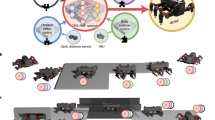Abstract
This paper proposes a novel method to design a robot by simultaneously improving its morphology and controller. The number of rigid parts of the robot and the layout of joints connecting them are represented by a rooted tree, which is called a discrete parameter. Meanwhile, parameters that can be represented by real values are called continuous parameters; these parameters include properties such as the length and the direction of each rigid part, as well as the weights and biases of the controller composed of a multilayer perceptron. For the discrete parameters, we propose an efficient improvement rule, which was established based on the actual evolution of vertebrates. For the continuous parameters, we apply the REINFORCE algorithm. By combining these two methods, we propose a method to simultaneously improve both the discrete and continuous parameters. The advantages of the proposed method are shown by comparison with other design strategies.






Similar content being viewed by others
Explore related subjects
Discover the latest articles and news from researchers in related subjects, suggested using machine learning.References
Parker RG, Rardin RL (2014) Discrete optimization. Elsevier, Amsterdam
Sims K (1994) Evolving virtual creatures. In: 21st Annual Conference on Computer Graphics and Interactive Techniques, pp 15–22
Ha D (2019) Reinforcement learning for improving agent design. Artif Life 25(4):352–365, arXiv:1810.03779
Williams RJ (1992) Simple statistical gradient-following algorithms for connectionist reinforcement learning. Mach Learn 8(3):229–256
Schulman J, Moritz P, Levine S, Jordan M, Abbeel P (2016) High-dimensional continuous control using generalized advantage estimation. In: International Conference on Learning Representations
Zhao A, Xu J, Konaković-Luković M, Hughes J, Spielberg A, Rus D, Matusik W (2020) RoboGrammar: Graph grammar for terrain-optimized robot design. ACM Trans Graph (TOG) 39(6):1–16
Xu J, Spielberg A, Zhao A, Rus D, Matusik W (2021) Multi-objective graph heuristic search for terrestrial robot design. In: 2021 IEEE International Conference on Robotics and Automation (ICRA), IEEE, pp 9863–9869
Gupta A, Savarese S, Ganguli S, Fei-Fei L (2021) Embodied intelligence via learning and evolution. Nat Commun 12:1–12, arXiv:2102.02202
Coates MI (2003) The evolution of paired fins. Theory Biosci 122(2–3):266–287
Gilbert SF (2000) Developmental biology. Sinauer Associates, Inc
Shubin N, Tabin C, Carroll S (1997) Fossils, genes and the evolution of animal limbs. Nature 388(6643):639–648
Uhen MD (2007) Evolution of marine mammals: back to the sea after 300 million years. Anatom Record 290(6):514–522
Hall BK (1975) Evolutionary consequences of skeletal differentiation. Am Zool 15(2):329–350
Brockman G, Cheung, Vicki and Pettersson L, Schneider J, Schulman J, Tang J, Zaremba W (2016) OpenAI Gym. arXiv preprint arXiv:1606.01540
Coumans E, Bai Y (2016) PyBullet, a Python module for physics simulation for games, robotics and machine learning
Author information
Authors and Affiliations
Corresponding author
Additional information
Publisher's Note
Springer Nature remains neutral with regard to jurisdictional claims in published maps and institutional affiliations.
This work was presented in part at the joint symposium of the 27th International Symposium on Artificial Life and Robotics, the 7th International Symposium on BioComplexity, and the 5th International Symposium on Swarm Behavior and Bio-Inspired Robotics (Online, January 25–27, 2022).
About this article
Cite this article
Koike, R., Ariizumi, R. & Matsuno, F. Automatic robot design inspired by evolution of vertebrates. Artif Life Robotics 27, 624–631 (2022). https://doi.org/10.1007/s10015-022-00793-4
Received:
Accepted:
Published:
Issue Date:
DOI: https://doi.org/10.1007/s10015-022-00793-4




